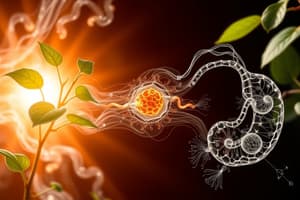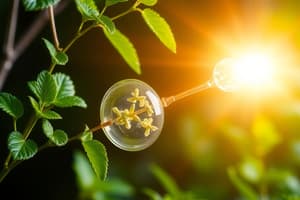Podcast
Questions and Answers
Define energy. What is the ultimate source of energy for all life on earth?
Define energy. What is the ultimate source of energy for all life on earth?
Energy is defined as the ability to do work. The ultimate source of energy is the sun.
What are the two classifications of organisms based on how they obtain their energy?
What are the two classifications of organisms based on how they obtain their energy?
- Consumers (correct)
- Producers (correct)
- Autotrophs (correct)
- Heterotrophs (correct)
Which of the following organisms are considered autotrophs?
Which of the following organisms are considered autotrophs?
- Fungi
- Bacteria (correct)
- Plants (correct)
- Animals
Photosynthesis is divided into 2 stages: the light dependent reaction and the ______.
Photosynthesis is divided into 2 stages: the light dependent reaction and the ______.
What occurs during the light dependent reaction of photosynthesis?
What occurs during the light dependent reaction of photosynthesis?
What would happen if carbon dioxide was removed from the plant's environment?
What would happen if carbon dioxide was removed from the plant's environment?
What are the equations used to represent photosynthesis and cellular respiration?
What are the equations used to represent photosynthesis and cellular respiration?
What type of cellular respiration occurs with oxygen?
What type of cellular respiration occurs with oxygen?
What is the order of stages in cellular respiration when oxygen is present?
What is the order of stages in cellular respiration when oxygen is present?
What name is given to the process of making ATP without oxygen?
What name is given to the process of making ATP without oxygen?
Some organisms that make their own food do not use light and are called ______.
Some organisms that make their own food do not use light and are called ______.
Flashcards are hidden until you start studying
Study Notes
Energy Definition and Source
- Energy is the ability to do work, with the sun as the ultimate energy source for all life on Earth.
Organism Classification by Energy Source
-
Autotrophs (Producers):
- Produce their own food via photosynthesis.
- Examples include plants, algae, and some bacteria.
-
Heterotrophs (Consumers):
- Depend on other organisms for food.
- Examples include animals, fungi, and some single-celled organisms.
Photosynthesis Stages
-
Light-dependent reactions:
- Occur in the thylakoid membrane, converting light energy into chemical energy (ATP and NADPH).
- Water is utilized, and oxygen is released as a byproduct.
-
Calvin Cycle (Light-independent):
- Takes place in the stroma of chloroplasts, producing glucose by combining carbon from CO2 with energy from ATP and NADPH.
-
Pigments:
- Chlorophyll absorbs sunlight, found in chloroplasts, essential for the light-dependent reactions.
Impact of CO2 Removal on Photosynthesis
- Removing carbon dioxide halts glucose production, leading to food scarcity for plants.
- Photosynthesis requires water, and inadequate temperature can slow the process.
Equations of Photosynthesis and Cellular Respiration
- Photosynthesis equation: 6CO2 + 6H2O + sunlight → C6H12O6 + 6O2.
- Cellular respiration equation: C6H12O6 + 6O2 → 6H2O + 6CO2 + energy.
- These reactions are inverses of each other.
- Glucose formula: C6H12O6.
Types of Cellular Respiration
- Aerobic respiration occurs in organisms with mitochondria (eukaryotes) and uses oxygen.
- Anaerobic respiration occurs in all cell types (prokaryotes and eukaryotes) without utilizing oxygen.
Cellular Respiration Stages
-
Glycolysis:
- Occurs in the cytoplasm.
- Produces 2 ATP, NADH, and pyruvate.
-
Krebs Cycle:
- Takes place in the mitochondrial matrix.
- Produces 2 ATP, carbon dioxide (CO2), and energy carriers NADH and FADH2.
-
Electron Transport Chain:
- Situated in the inner mitochondrial membrane.
- Produces 32 ATP and water.
ATP Production Without Oxygen
- Fermentation is the process of ATP production without oxygen.
- Types of fermentation:
-
Alcoholic fermentation:
- Conducted by yeast and bacteria, producing CO2, 2 ATP, and ethanol.
-
Lactic acid fermentation:
- Occurs in muscle cells, resulting in 2 ATP and lactic acid.
-
Organisms and Light for Food Production
- Not all organisms that produce their own food depend on light; some, like certain bacteria, utilize chemical compounds.
- These organisms are referred to as chemosynthetic.
Studying That Suits You
Use AI to generate personalized quizzes and flashcards to suit your learning preferences.




